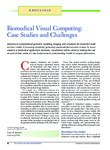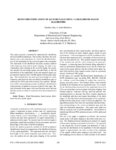|
|
Creator | Title | Description | Subject | Date |
| 326 |
 |
Furse, Cynthia M. | Biomedical telemetry: today's opportunities and challenges | Biomedical telemetry is used today to communication with cardiac devices, insulin pumps, and a few other implantable devices that are on the order of 1-2" in diameter. Future systems promise advanced communication with cardiac, optical, neurological and auditory devices that are on the order of a ce... | | 2009-03 |
| 327 |
 |
Johnson, Christopher R. | Biomedical visual computing: case studies and challenges | Advances in computational geometric modeling, imaging, and simulation let researchers build and test models of increasing complexity, generating unprecedented amounts of data. As recent research in biomedical applications illustrates, visualization will be critical in making this vast amount of data... | | 2012-01-01 |
| 328 |
 |
Christensen, Douglas A. | Biosensor development at the University of Utah | Interest in biosensors has increased rapidly in the past few years due to the many potential advantages of these devices, such as small size, speed of response, and specificity 111. The term "biosensor" in the broad sense describes any device or apparatus which detects biological signals for the pu... | Silicon retina; Photosensing array; CHEMFET; Fluorescence lmmunosensor; Planar waveguide | 1994-07 |
| 329 |
 |
Gerpheide, George E. | Bit-driven logic: a style of digital logic for VLSI design | This memo describes a new style of low-level digital logic design called Bit-Driven Logic (BDL) which may prove attractive for the design of VLSI chips. BDL is an application of speed-independent, data-flow ideas to a very low level. It has the advantages of good locality, clockless operation, and... | Bit-Driven Logic; BDL; Digital logic design; VLSI chips | 1980 |
| 330 |
 |
Mathews, V. John | Blind identification of bilinear systems | Abstract This paper is concerned with the blind identification of bilinear systems excited by higher-order white noise. Unlike prior work that restricted the bilinear system model to simple forms and required the excitation to be Gaussian distributed, the results of this paper are applicable to a m... | | 2001 |
| 331 |
 |
Mathews, V. John | Blind identification of bilinear systems | Abstract-This paper is concerned with the blind identification of a class of bilinear systems excited by non-Gaussian higher order white noise. The matrix of coefficients of mixed input-output terms of the bilinear system model is assumed to be triangular in this work. Under the additional assumptio... | | 2003 |
| 332 |
 |
Mathews, V. John | Blind identification of QAM signals using a likelihood-based algorithm | This paper presents a method for automatically identifying different QAM modulations. This method identifies the modulation type as the hypothesis for which the likelihood function of the amplitudes of the received signal is the maximum. The derivation of the likelihood functions assumes additive wh... | | 2013-01-01 |
| 333 |
 |
Lenart, Joshua Bela | The Blue Castle project: a feasibility study of the proposed nuclear power plant in Emery County, Utah along the Green River | With an increasing population in Utah, specifically in the Salt Lake Valley, the demand for energy is rapidly growing each year. Currently, Utah's electric grid is largely produced by burning coal, natural gas, and other fossil fuels. In the past, supplying Utahns with electricity from these forms h... | Blue Castle; Utah; Nuclear power plant; Emery County | 2015-08 |
| 334 |
 |
Riloff, Ellen M. | Bootstrapping for text learning tasks | When applying text learning algorithms to complex tasks, it is tedious and expensive to hand-label the large amounts of training data necessary for good performance. This paper presents bootstrapping as an alternative approach to learning from large sets of labeled data. Instead of a large quantity ... | Bootstrapping; Text learning algorithms; Seed information | 1999 |
| 335 |
 |
Riloff, Ellen M. | Bootstrapping method for learning semantic lexicons using extraction pattern contexts | This paper describes a bootstrapping algorithm called Basilisk that learns high-quality semantic lexicons for multiple categories. Basilisk begins with an unannotated corpus and seed words for each semantic category, which are then bootstrapped to learn new words for each category. Basilisk hypothe... | Basilisk; Bootstrapping method; Semantic lexicons | 2002 |
| 336 |
 |
Hansen, Charles D. | Boundary aware reconstruction of scalar fields | In visualization, the combined role of data reconstruction and its classification plays a crucial role. In this paper we propose a novel approach that improves classification of different materials and their boundaries by combining information from the classifiers at the reconstruction stage. Our ap... | | 2014-01-01 |
| 337 |
 |
Tasdizen, Tolga | Boundary estimation from intensity/color images with algebraic curve models | A new concept and algorithm are presented for noniterative robust estimation of piecewise smooth curves of maximal edge strength in small image windows - typically 8 x 8 to 32 x 32. This boundary-estimation algorithm has the nice properties that it uses all the data in the window and thus can find l... | | 2000 |
| 338 |
 |
Gopalakrishnan, Ganesh | Bounded transaction model checking | Industrial cache coherence protocol models often have too many reachable states, preventing full reachability analysis even for small model instances (number of processors, addresses, etc.). Several partial search debugging methods are, therefore, employed, including lossy state compression using... | Model checking; Reachability analysis | 2006-02-27 |
| 339 |
 |
Harrison, Reid R. | Brain-machine interface, unplugged | In experiments and even limited human clinical trials, electrode arrays implanted on the brain's surface have given monkeys and humans the ability to move objects with their thoughts. The experiments are proof that brain-computer interfaces could improve the lives of severely paralyzed people. But... | Wireless neural implants; Brain-computer interface | 2009-01-01 |
| 340 |
 |
Freire, Juliana | Bridging the XML-relational divide with LegoDB: a demonstration | We present LegoDB, a cost-based XML storage mapping engine that automatically explores a space of possible XML-to-relational mappings and selects an efficient mapping for a given application. | LegoDB; Storage mappings | 2003 |
| 341 |
 |
Christensen, Douglas A. | Bringing an integrative modeling experience to a freshman biomedical engineering course | As an integrating lab experience in our Fundamentals of Bioengineering freshman course, we have included a Major Project that ties together many of the principles of biomechanics and bioelectricity covered in the lecture. It uses the human systemic cardiovascular system as a model. During the first... | Matlab | 2004 |
| 342 |
 |
Furse, Cynthia M. | Broadband and multiband antenna design using the genetic algorithm to create amorphous shapes using ellipses | A method is demonstrated for generating compact, broadband and multiband antennas using ellipses to create new amorphous shapes with greater bandwidth and less return loss that previously demonstrated. Four designs are presented including a tri-band patch antenna optimized for low reflection loss a... | Broadband antenna design; Multiband antenna design; Ellipses | 2006-10 |
| 343 |
 |
Ameel, Timothy A;Harvey, Ian R.; Miller, Mark S.; Blair, Steven; Gale, Bruce K.; Ring, Terry Arthur | Building academic, research, and commercialization programs in micro and nano science and engineering at the University of Utah | Abstract-This paper presents a case-study of some University /Government / Industry interactions at the University of Utah that build research and academic programs and create opportunities fur economic growth in the areas of micro and nanu science and engineering. | | 2003 |
| 344 |
 |
Brandt, Richard C. | Building databases for the computer-based memorization system | The Computer-Based Memorization System (CBMS) consists of eight games used by students to memorize groups of related facts that are stored in an associative network. The instructional design is built into the games. Designing and implementing associative networks for the CBMS is very different from... | Computer-Based Memorization System; CBMS | 1988 |
| 345 |
 |
Starkey, Mike | C-RISC A C language reduced instruction set computer | This project is the implementation of a Reduced Instruction Set Computer (RISC) on a tiny chip. RISC technology is based on the idea that a small number of simple instructions can be used to create a fast, flexible computer. Our RISC uses this principle while staying within the confines of the tiny ... | RISC; C language | 1990 |
| 346 |
 |
Stevens, Kenneth | CA-BIST for asynchronous circuits: a case study on the RAPPID asynchronous instruction length decoder | This paper presents a case study in low-cost noninvasive Built-In Self Test (BIST) for RAPPID, a largescale 120,000-transistor asynchronous version of the Pentium® Pro Instruction Length Decoder, which runs at 3.6 GHz. RAPPID uses a synchronous 0.25 micron CMOS library for static and domino lo... | | 2000 |
| 347 |
 |
Weinstein, David | Cache-rings for memory efficient isosurface construction | Processor speeds continue to increase at faster rates than memory speeds. As this performance gap widens, it becomes increasingly important to develop "memory-conscious" algorithms - programs that still optimize instruction count and algorithmic complexity, but that also integrate optimizations for ... | Processor speeds; Memory speeds; Computer memory; Cache-rings | 1997 |
| 348 |
 |
Stevens, Kenneth | CAD directions for high performance asynchronous circuits | This paper describes a novel methodology for high performance asynchronous design based on timed circuits and on CAD support for their synthesis using Relative Timing. This methodology was developed for a prototype iA32 instruction length decoding and steering unit called RAPPID ("Revolving Asynchro... | | 1999 |
| 349 |
 |
Hansen, Charles D.; Henderson, Thomas C. | CAD-based 3-D object recognition | We propose an approach to 3-D object recognition using CAD-based geometry models for freeform surfaces. Geometry is modeled with rational B-splines by defining surface patches and then combining these into a volumetric model of the object. Characteristic features are then extracted from this model ... | Object recognition; Strategy trees; Geometric knowledge representation; Automatic feature selection | 1989 |
| 350 |
 |
Hansen, Charles D. | CAD-based computer vision: the automatic generation of recognition stragtegies | Three-dimensional model-based computer vision uses geometric models of objects and sensed data to recognize objects in a scene. Likewise, Computer Aided Design (CAD) systems are used to interactively generate three-dimensional models during these fields. Recently, the unification of CAD and vision s... | | 1988 |

























